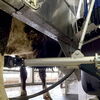
Processing Your Payment
Please do not leave this page until complete. This can take a few moments.
With much of Maine's construction workforce retiring, contractors are looking for workers
 Photo / Jim Neuger
Students Juno Gilman, Laurel Freedner and Mica Foster apply drywall in a class at the construction technology department at SMCC.
Photo / Jim Neuger
Students Juno Gilman, Laurel Freedner and Mica Foster apply drywall in a class at the construction technology department at SMCC.
Who will construct roads, bridges, homes, commercial buildings, energy infrastructure, and more when the state’s veteran builders retire?
Maine’s construction workforce will have less to do with the industry’s incremental growth, and more to do with the high percentage of expected departures among skilled tradespeople in the coming decade.

“The [Maine] Department of Labor says we’re growing at 2% [annually] over the next 30 years, but in eight years, 41% of the current carpenters are retiring,” says David Eng, dean of Southern Maine Community College’s department of construction technology and heavy equipment.
It’s a problem and an opportunity for anyone who wants to use both their head and hands, and who doesn’t mind occasional exertion and discomfort. In exchange, Maine builders say, construction workers receive good pay, even better job security and a great deal of freedom to pursue a career that suits their interests.
The projected worker shortfall has caused employers and educators to intensify and broaden their efforts to attract more Mainers into the trades. They’ve bolstered old approaches and invented new ones, such as short-duration courses and night classes to teach basic skills.
One example is the Associated General Contractors of Maine’s new Maine Construction Academy, a program funded with federal COVID-19 relief money via the state Labor Department that is offering apprenticeships and pre-apprenticeships in skills such as carpentry, welding, concrete finishing, crane operation and heavy highway labor.
The six-week programs, available at seven sites across the state, will be able to accommodate up to 140 participants in its inaugural year, with plans to double that capacity the following year, says AGC Maine Executive Director Kelly Flagg.
“There’s a disconnect between the existing educational programs that exist and the actual industry,” Flagg says. “There’s been a little bit of a challenge with getting students and/or potential workers from, say, a career and technical education center into the actual workforce and on a jobsite. This program is designed to fill that gap.”
Construction Academy classes are free, and every student receives a free pair of heavy work boots valued at $200, she adds. That’s how badly the industry wants people to sign up.

Pervasive need
Virtually every construction firm in the state is actively searching for workers, says Robin Wood, director of human resources at Reed & Reed Inc. in Woolwich. The 95-year-old firm builds everything from cable bridges to industrial facilities, marine terminals and wind farms.
“It’s a real struggle, and we are all competing for the same labor force,” Wood says. “We all have positions available that we are unable to fill. The ability to hire can and does directly determine the amount of work companies are able to bid on.”
Demand for workers is the strongest Wood has ever seen. Despite construction work being deemed essential in the early days of the COVID-19 pandemic, contractors still had difficulty finding and hiring enough employees, she says.
“Now, three years later, we’re still trying to figure out where all the workers went,” says Wood. “If we want them, we’re going to have to train them ourselves, and we are geared up and ready for this challenge.”
The question of how to recruit more workers tends to dominate office conversations lately, says Jonathan Smith, president of Great Falls Construction in Gorham. The 65-employee firm specializes in residential, commercial and municipal buildings, including the restoration of historically significant structures.
It’s a challenge just to find enough people to take on new projects, Smith says, adding that the problem is by no means limited to the construction industry. Many industries in Maine and nationwide are experiencing worker shortages, he says.
“Our HR team members are focused on really just interacting as much as possible with (prospective) next-generation team members,” says Smith, “and that’s from age groups as low as elementary school all the way up through college students.”
There used to be a reliable pipeline of new talent into the industry through high school vocational programs and family farms, he says, but that pipeline has mostly dried up. The challenge now is to introduce more young people to an industry they likely know very little about.
Not what people think
It has gotten to the point where most Maine construction firms will be happy to take in anyone off the street and train them, says Tim Ouellette, CEO and chief financial officer of CPM Constructors in Freeport. CPM focuses on bridge, pile-driving, railroad, historic rehabilitation and marine construction work across Maine and northern New England.
One of the biggest challenges is overcoming negative perceptions that the industry is too hard, too dirty and too uncomfortable to work in outdoors, according to Ouellette. What most people don’t know, he says, is how fulfilling and flexible a career in construction can be.
Firms such as CPM have been forced to master the ways of online social media in order to reach the young audiences they seek, Ouellette addsz.
“That’s been more recent, in the last year or two,” he says, “because we were, admittedly, not very good at it initially.”
Recruiting challenges have existed in the industry for about a decade but have worsened over the past few years, says Eric Ritchie, vice president and chief operating officer at employee-owned heavy civil earthwork contractor Sargent in Orono.
Sargent has added human resources and workforce advancement staff and, like CPM, has been conducting outreach through multiple channels including social media, campus visits, job fairs and its own construction academy for high school graduates and young adult workers.
“We’ve been offering a variety of things like that, as well as just trying to get out there and show people how, for lack of a better way to put it, how cool our industry really is,” Ritchie says. “There’s some amazing things that you can do.”

Some students get it
Some young people, including 20-year-old Noah Forget, say they don’t need to be convinced that the industry is for them. He is one of the students in Eng’s construction technology program at SMCC.
During a recent class, Forget and his classmates were practicing putting up drywall in a training environment that simulates a real jobsite. Forget says he sees a lot of benefits to working in construction.
“You get to work outside — it doesn’t get any better than that,” he says. “I love this program — I think the teachers have done a phenomenal job with it. They make it fun.”
Jared Biaya, 18, says he enrolled in the program because he wants to help people and enjoys building things.
Biaya notes that Maine has a severe shortage of affordable housing, and that going into construction is one way to help solve the problem.
“There are no [available] houses anywhere right now,” he says.
Laurel Freedner, also 18, praised the SMCC program. She says it offers “a little taste of everything” and emphasizes real-world skills.
“I’m hoping to get into finishing work, and possibly starting my own company at some point,” Freedner says.











0 Comments